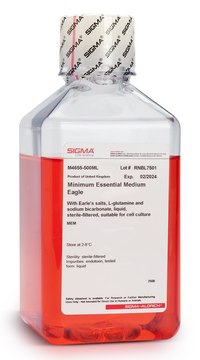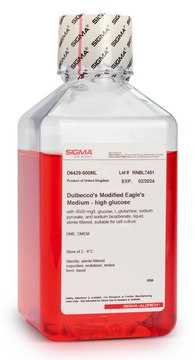Kluczowe dokumenty
B1522
Basal Medium Eagle
With Earle′s salts and sodium bicarbonate, without ʟ-glutamine, liquid, sterile-filtered, suitable for cell culture
Synonim(y):
BME
About This Item
Polecane produkty
Nazwa produktu
Basal Medium Eagle, With Earle′s salts and sodium bicarbonate, without L-glutamine, liquid, sterile-filtered, suitable for cell culture
sterylność
sterile-filtered
Formularz
liquid
metody
cell culture | mammalian: suitable
zanieczyszczenia
endotoxin, tested
komponenty
L-glutamine: no
NaHCO3: yes
Earle’s salts (5% CO2): yes
Warunki transportu
ambient
temp. przechowywania
2-8°C
Szukasz podobnych produktów? Odwiedź Przewodnik dotyczący porównywania produktów
Opis ogólny
Zastosowanie
- as a component in the culture medium for cochlear organotypic cultures and salicylate treatment
- to maintain cerebellar granule neurons (CGNs) to determine if there is a system that regulates the distribution and/or group dynamics of axonal mitochondria
- in the preparation of cortical slices, serum-free medium, and slice culture medium for slice overlay assay to study the influence of extracellular signals on neuronal development
Rekonstytucja
najczęściej kupowane z tym produktem
Kod klasy składowania
12 - Non Combustible Liquids
Klasa zagrożenia wodnego (WGK)
WGK 1
Temperatura zapłonu (°F)
Not applicable
Temperatura zapłonu (°C)
Not applicable
Wybierz jedną z najnowszych wersji:
Masz już ten produkt?
Dokumenty związane z niedawno zakupionymi produktami zostały zamieszczone w Bibliotece dokumentów.
Klienci oglądali również te produkty
Produkty
Cell culture protocol for passaging and splitting suspension cell lines
Protokół hodowli komórkowej do pasażowania i dzielenia zawiesinowych linii komórkowych
Wapń jest jonowo stabilnym dwuwartościowym kationem o ważnych korzystnych i toksycznych właściwościach w hodowli komórkowej. Jest składnikiem szerokiej gamy pożywek do hodowli komórkowych.
Nasz zespół naukowców ma doświadczenie we wszystkich obszarach badań, w tym w naukach przyrodniczych, materiałoznawstwie, syntezie chemicznej, chromatografii, analityce i wielu innych dziedzinach.
Skontaktuj się z zespołem ds. pomocy technicznej









